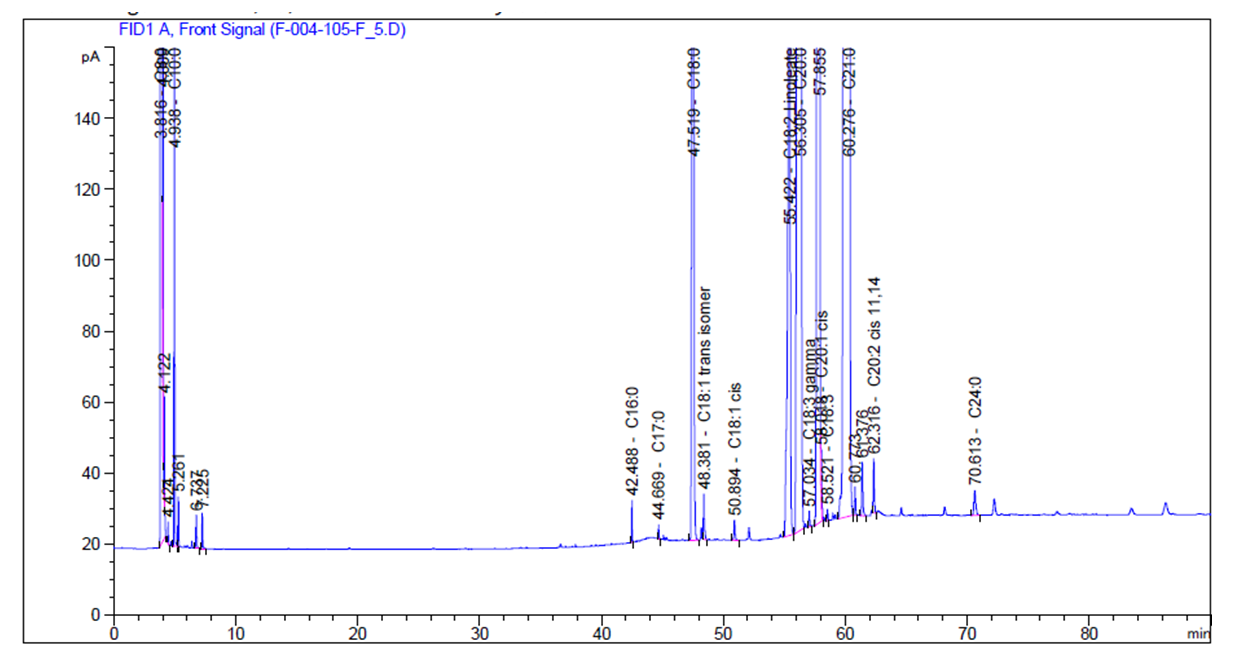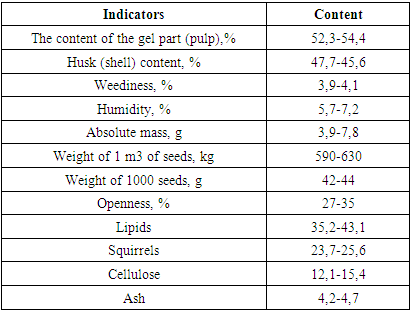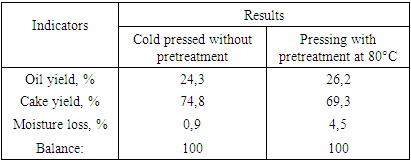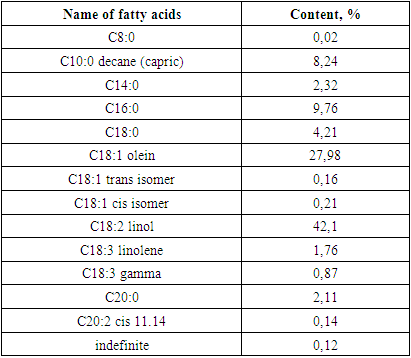-
Paper Information
- Paper Submission
-
Journal Information
- About This Journal
- Editorial Board
- Current Issue
- Archive
- Author Guidelines
- Contact Us
International Journal of Materials and Chemistry
p-ISSN: 2166-5346 e-ISSN: 2166-5354
2023; 13(1): 11-17
doi:10.5923/j.ijmc.20231301.03
Received: May 10, 2023; Accepted: May 26, 2023; Published: May 31, 2023

Investigation of Morphological and Physical-Chemical Parameters of Melon Seeds from the Chillaki Variety
Shoira Israilova1, Kamar Serkayev1, Jasur Farmonov1, 2, Madina Khamidova1, 2, Sabinaruzmetova1, 2, Mumtoz Abrorova1, 2
1Tashkent Chemical-Technological Institute, Тashkent, Uzbekistan
2The Economical and Pedagogical University, Karshi, Uzbekistan
Correspondence to: Shoira Israilova, Tashkent Chemical-Technological Institute, Тashkent, Uzbekistan.
| Email: |  |
Copyright © 2023 The Author(s). Published by Scientific & Academic Publishing.
This work is licensed under the Creative Commons Attribution International License (CC BY).
http://creativecommons.org/licenses/by/4.0/

The purpose of the research was to study the possibility of complex processing of melon seeds to obtain melon oil and high-protein cake based on local raw materials. Morphological and physico-chemical characteristics of melon seeds of the widely grown Chillaki variety have been determined. Melon seeds have a high content of crude protein and oil. The fatty acid composition and the amount of fatty acids of the oil obtained by pressing were studied. Chromatographic and spectrometric studies have shown that the oil contains 13 fatty acids, mainly linoleic (42.10%) and oleic (27.98%). The content of palmitin (9.76%), stearin (4.21%) and decanoic acid below 10% was determined, which means the functionality of the resulting product. The rich micro and macronutrient composition of cake determines its use as a vitamin and protein component of food products.
Keywords: Melon seeds, Oil, Proteins, Fatty acids, Mineral components
Cite this paper: Shoira Israilova, Kamar Serkayev, Jasur Farmonov, Madina Khamidova, Sabinaruzmetova, Mumtoz Abrorova, Investigation of Morphological and Physical-Chemical Parameters of Melon Seeds from the Chillaki Variety, International Journal of Materials and Chemistry, Vol. 13 No. 1, 2023, pp. 11-17. doi: 10.5923/j.ijmc.20231301.03.
1. Introduction
- As experts know, the fat-and-oil industry of the Republic of Uzbekistan was focused on the processing of cotton seeds obtained from 6 million tons of raw cotton and the production capacity was 3,600 thousand tons per year in terms of raw materials. This led to the construction of several gigantic factories, the production capacity of which reached 1200 tons per day. This led to an increase in the 2000s in the processing capacity of oilseeds up to 4,000 thousand tons per year. Despite the conservation of some capacities, in 2022 production capacities amounted to 3,300 thousand tons for cotton seeds and more than 1.1 million tons for processing non-traditional oilseeds. It should be noted that soybean and sunflower processing capacities did not exist in the 2000s. Today, the sources of oilseeds are approximately 1,300 thousand tons per year.Despite the large production capacity and all efforts to increase oilseeds, the country remains highly dependent on imports for certain types of oil and fat products. In 2022, more than 52% of vegetable oil resources were formed in the country's food market due to imports.It should be noted that 300 of the existing 500 enterprises are small and cannot conclude import contracts for a large batch of raw materials on their own, because working capital of these enterprises does not allow this. When it comes to raw materials, we mainly mean sunflower seeds. But the seeds of soybean, flax, rapeseed, sesame, safflower are also in demand on the Uzbek market. Feed additives cover part of the costs due to demand.Meanwhile, there is a large stock of waste from the canning and wine industry, such as seeds of grapes, pomegranate, melon, watermelon, tomato, stone fruits, which are currently used irrationally. Also, it is possible to produce functional pharmaceutical oils.In the Republic of Uzbekistan, the annual cultivation of various varieties of melon is 1056 thousand tons and is growing rapidly throughout the country. Considering that melon seeds make up more than 3% of the total mass, more than 32 thousand tons of seeds are lost annually, from which 14 thousand tons of functional edible oil could be obtained.Also, other sources of oil are practically lost due to the lack of organization of collection and the lack of regulated technologies for processing these seeds. If we organize the collection and processing of at least half of the existing sources of raw materials, then the annual income in the republic will be more than 250 million US dollars, which means covering the entire amount of imports of sunflower oil.The composition of melon oil is dominated by unsaturated fatty acids and natural melon oils are represented by linolenic, linoleic and oleic, while saturated ones include palmitic and stearic. Thanks to this composition, the beneficial properties of melon oil are obvious, which determine the use of this plant product in the fields of medicine and food production.Based on the foregoing, we have studied the physicochemical and quality indicators of dried seeds of the Chillaki melon variety in order to determine the possibility of complex processing and wide use of the products obtained from it, including cake in the food direction.
2. Materials and Methods
- The object of the study was the melon seeds of the Chillaki variety. Melon is an annual plant of the gourd family with a well-developed root system. Its main tap root penetrates to a depth of 4 m. Lateral roots are located mainly in the near-surface soil layer. Above-ground shoots reach a length of 3 m, strongly branched, stiff-haired, with antennae, hollow inside. Unlike watermelon, melon leaves are not separate, but whole or five-lobed, round or kidney-shaped, up to 14 cm long, up to 20 cm wide [1, p.16]. The flowers are large, orange-yellow, with a deeply five-parted corolla. Male flowers are collected 5-15 in because. to obtain. The female flowers are solitary, larger than the male ones. Along with dioecious flowers, bisexual flowers sometimes occur, and underdeveloped stamens are found in female flowers. Fruits of different varieties differ in shape and size, weight, taste, color of the pulp and peel. The length of the fruit ranges from 4 cm to 2 m, and the weight - from several tens of grams to 20 kg. Seeds are white or cream, 0.5 to 1.5 cm long [2].Seeds from mature and fresh samples were used in the studies. Analyzes were carried out in three parallel samples in accordance with the methodology. At the first stage of the research, the morphological composition of the seeds was determined, i.e. the content of pulp, protein and other substances in it, husks, moisture, oil and other indicators. At the second stage of the research, melon oil was obtained from the seeds of the Chillaki melon variety by pressing.We have chosen a Chinese-made ZX-130 press for processing samples. The press is designed in such a way that it can work in 2 modes, i.e. and in the "prepress" and "expeller" modes.The analysis of the obtained pressing oil was carried out according to the following methods:- color of oils on the Lovibond color meter;- the acid number of oils was determined and a 1% alcohol solution of phenolphthalein was used as an indicator [4, 10 p.]. The method is based on the titration of an oil sample with an alkali solution in the presence of the phenolphthalein indicator. A neutralized mixture of alcohol and diethyl ether was used as a solvent for the oil. K.ch. (in mg KOH/g) was calculated according to the formula C.h. \u003d 5.611 a k / m, where: 5.611 - titer to 0.1 n potassium hydroxide solution, ml; a - the amount of 0.1 n caustic alkali solution used for titration, ml; k - titer correction; m is the mass of the analyzed oil, g;- the mass fraction of moisture and volatile substances was determined;- the degree of oxidation of oils was assessed by the peroxide value determined by the iodometric method;- the oil content in the processed materials was determined by the exhaustive extraction method in the Naaba apparatus [8, 661 s];- humidity of oil-containing materials and miscella concentration were analyzed by the gravimetric method [9, 18 p.];- the content of crude protein and its soluble fractions in cakes was determined by the Kjeldahl macromethod [10, 302 p.].- to study the physico-chemical composition of the obtained oils, a Clarus 600 Perkin-Elmer gas chromatograph (USA) was used in the laboratory of applied technologies of the Institute of Bioorganic Chemistry of the Academy of Sciences of the Republic of Uzbekistan. Quantitative analysis of fatty acids was carried out under the following conditions: column - Restek, Stabillwax, column length - 60 m, column diameter - 0.32 mm, detector - FID, conveyor gas - nitrogen, thermostat temperature of the temperature gradient - 1-8 min, 80°C; 8-18 min, 130°C; 18-22 min, 180°C; split - 1/10; injection amount - 1 µl. Fatty acids were methylated based on derivatization.
3. Literature Review
- In industry, vegetable oils are extracted from oilseeds by pressing (cold or hot) or organic solvents. Also, a combined method is used, including pressing, followed by extraction of oil from the cake with a liquid solvent. When it comes to functional raw materials, it is worth noting that for stone fruit and fruit and vegetable seeds, the development of a press method for extracting oil is promising, because. Pressed oil is considered more valuable, especially cold-pressed [11].Cold pressing is one of the pressing methods without heat or at low temperature. After cold pressing, the temperature of the oil and the acidity coefficient are low. Cold-pressed oil (except cottonseed oil) usually does not require refining, and after precipitation and filtration, the finished oil is obtained [12, p.88-96; 13, p.40-51].Melon seed oil, rich in linoleic acid, is used for frying and cooking in parts of Africa and the Middle East due to its unique flavor. Many studies have been published on the oxidative stability of vegetable or fruit oils, but little has been reported on the stability of melon seed oil. Modification of the fatty acid composition of melon seed oil by the inclusion of oleic acid (18:1) was investigated. Modified melon seed oil was obtained with a better balance of monounsaturated (18:1) and essential fatty acids (18:2), and improved the seed oil's oxidative stability and nutritional value [14].The dependence of the oil yield, the mass fraction of crude protein and the residual oil content in the cake on the content of the fruit shell in the processed melon of the Amiri variety grown in Tajikistan was investigated. Melon seeds with an oil content of 35.3% were treated with IR irradiation with heating up to 90°C. Then they were brought down with a single blow in a modernized centrifugal roller. Samples of a model mixture of the core fraction of melon seeds with a fruit shell content of 8, 14, 20 and 25% were prepared from the resulting roll. Before oil extraction, each sample of the sound fraction was heated to a temperature of 68-70°C in an installation with an IR power supply. The humidity of the samples was (6.0 ± 0.2)%. The extraction of oil from melon seeds was carried out in bench conditions on a DUO screw press (Farmet a.s). It was found that with a decrease in the content of the fruit shell in the core fraction up to 8%, the yield of melon oil increases to 37%, the content of crude protein in the cake on an absolutely dry substance increases to 56%, the oil content of the resulting cake decreases to 9%. At the same time, the quality indicators of melon oil are improved [15].Research results show a high content of not only oil, but also protein in melon seeds. In our opinion, special attention should be paid to the protein content in this raw material, because the production of vegetable proteins in our Republic of Uzbekistan, despite the pissimistic results of the FAO and WHO analyzes, lags behind world producers. Observations show that there is a growing shortage of dietary protein in the world and its shortage is likely to continue in the coming decades. On average, the inhabitants of the Earth consume about 60 g of protein per day, at a rate of 70 g. The total protein deficiency is estimated at 20-25 million tons per year. Of the 7 billion people living on Earth, approximately half suffer from protein deficiency [16].Climate change is exacerbating and already disrupting the production of staple crops such as wheat, rice, and maize in tropical and temperate zones, and without improved climate resilience, the situation is expected to worsen as average temperatures rise and extreme weather events become more frequent [12].Today, 821 million people worldwide suffer from hunger or malnutrition, and 144 million young children are stunted, which also indicates the presence of hidden hunger [18]. The FAO claims that the pandemic has led to an increase in the number of people suffering from overweight and obesity worldwide. According to the release of the 2020 SOFI report, as a result of the COVID-19 pandemic, more than three billion people on the planet will not be able to afford healthy food [14].A promising way to increase the resources of food protein is to increase the productivity of crop and livestock production based on the technologies for cultivating legumes, oilseeds, and cereals used both directly for food and for livestock feed [15].In accordance with the recommendations of WHO and FAO, the value of the optimal protein requirement is 60-100 g per day, or 12-15% of the total caloric intake of food. In the total amount of energy, protein of animal and vegetable origin accounts for 6-8% each. In terms of 1 kg of body weight, the protein requirement per day in an adult is on average about 1 g, while for children, depending on age, it ranges from 1.05 to 4.00 g [19].Increasing the amount of dietary protein through animal husbandry is less promising compared to crop production, because to obtain 1 kg of animal protein, 5-8 kg of feed protein is required. The coefficients of transformation of vegetable proteins into proteins of fed animals are very low (25–39%), and therefore 60–75% of the protein is lost in the food chain in undigested residues [16].Analysis of sources of information, although the results of not so many studies are known, shows that melon seeds, like the pulp, are rich in valuable food ingredients. The melon variety called Chillaki is a widely cultivated variety throughout the republic, and therefore we decided to investigate the physico-chemical parameters of dried seeds of this particular variety.
4. Results
- Mature melon seeds are a type of seed without endosperm. They consist of an embryo with large cotyledons and a seed coat. The seeds vary little in appearance and size. The morphological parameters of the studied seeds corresponded to the average statistical parameters, i.e. classified as medium size (length 1.14-1.18 cm, width 0.41-0.49 cm and thickness 0.21-0.36 cm).The content of seed pulp was 52.3-54.4% of the total mass. Accordingly, the husk content varied from 45.6 to 47.7%. Morphological and physicochemical parameters of the studied seeds are given in Table. 1.
|
|
|
 | Figure 1. Chromatogram of pressed melon oil obtained by preliminary GTO |
 | Figure 2. IR spectrum of expeller melon oil obtained by preliminary TRP |
|
|
5. Conclusions
- The data presented suggest that melon seeds can be a useful product with good nutritional value. Melon seeds are high in crude protein and oil. A particularly high content was found in the kernel - up to 38% protein and 52% oil. The seed oil contains linoleic acid, which is a major fatty acid (42,15). Oil can be obtained from seeds, and cake, due to the high content of protein substances, can be used in the diet as a vitamin-protein component. We have begun research on the development of technology for protein flour and concentrate based on melon cake and meal.
 Abstract
Abstract Reference
Reference Full-Text PDF
Full-Text PDF Full-text HTML
Full-text HTML



